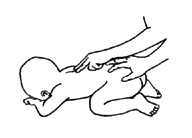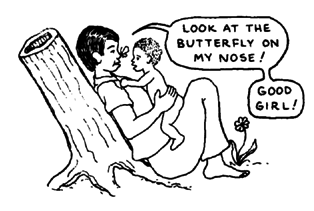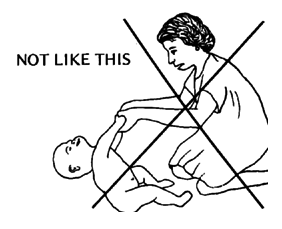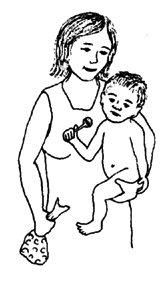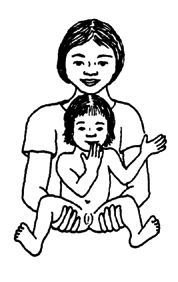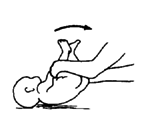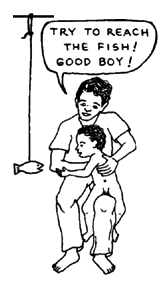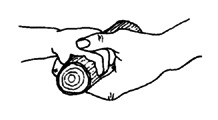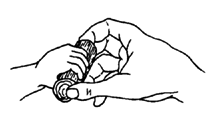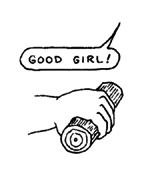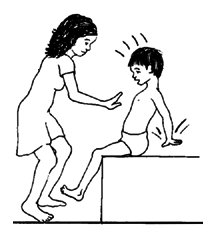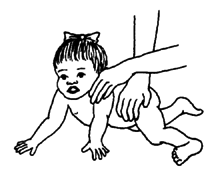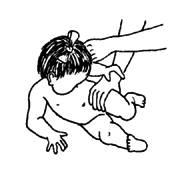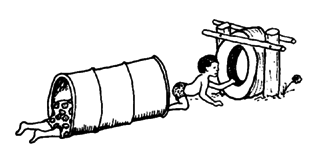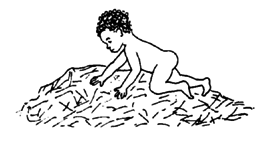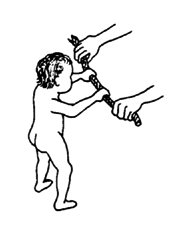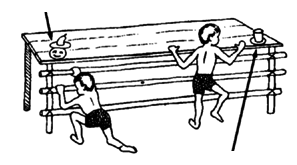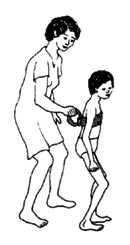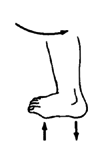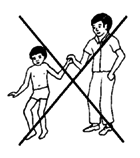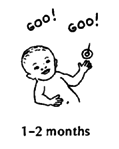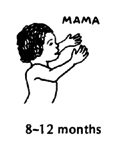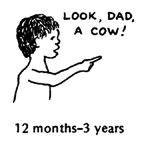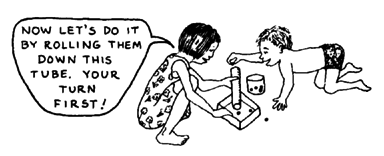CHAPTER 35
Early Stimulation and Development Activities
On the next Pages are activities to help young children's development. They are especially valuable for children who are mentally and physically delayed. They are also useful for children who are mentally normal but whose physical disabilities make both physical and mental development slow or difficult.
In this chapter we describe activities for early skills in the order in which they usually develop. So we start with head control, then progress to more advanced levels: reaching, grasping, sitting and balance, scooting or crawling, standing and walking, and language. (Self-care activities including eating, dressing, and toilet training are discussed in later chapters.)
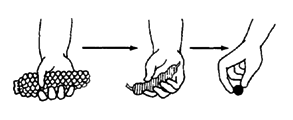
In any area of development, such as head control or use of the hands, a child also advances through different stages of ability. For example, in developing grip, first a child can grasp only with the whole hand, later with thumb and finger.
To decide which activities to begin with, start by using the charts on Pages 292 and 293 to determine the developmental level of your child. Then look through Pages 302 to 316 and pick those activities that are next in line for your child. After she learns these activities, go on to the next.
A child advances in many areas of development at once. Try to help her in several areas at the same time. In each area, pick activities that help her do better what she already does, and then to take the next step.
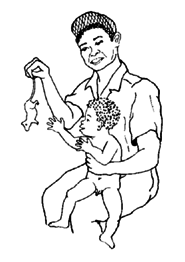
Often an activity that helps a child to develop in one area also helps in others.
For example, we put the activity with this picture under "head control." But the activity also helps to develop use of the senses (eyes, touch, sound), hand control, eye-hand coordination, balance while sitting, and flexibility of the body (twisting to one side). It done in a friendly way, with praise, it can develop confidence and ability to relate to other people. And if father talks to the child as they play, naming each object and action, it also prepares the child for learning language.
When helping your child with these learning activities, remember to introduce new skills in small steps that the child can easily learn. Praise her each time she succeeds, or tries hard. Follow the suggestions on Pages 296 to 299 for helping the child develop these new skills.
![]()
| CAUTION: Many activities in this chapter are useful for children with cerebral palsy or other physical disabilities. However, some must be changed or adapted. Read the chapters that apply to your child's disability. Above all: USE YOUR HEAD. OBSERVE HOW YOUR CHILD RESPONDS. NOTICE HOW AN ACTIVITY HELPS-OR HINDERS-THE CHI LD'S WHOLE DEVELOPMENT. DO NOT SIMPLY FOLLOW THE INSTRUCTIONS. ADAPT OR INVENT ACTIVITIES TO MEET YOUR CHILD'S NEEDS. |
1. Activities to help the child lift and control her head (and use her eyes and ears)
![]()
One of the first skills a normal baby develops is the ability to lift the head and control its movement. Head control is needed before a child can learn to roll, sit, or crawl. Normally, a newborn child can lift or hold her head up for a moment, and she develops fairly good head control in the first months of life. Children with developmental delay are often slow to develop head control. We need to help them to develop reasonable head control before trying to help them to roll, sit, crawl, or walk.
| To encourage the child to raise her head
when lying face down, attract her attention
with brightly colored objects that make strange or pretty
sounds.
|
| If she does not lift her head, to help her, put
her like this. Press firmly on the muscleson each side
of the backbone and slowly bring your hand from her neck toward
her hips.
|
| If the baby has trouble raising her head
because of a weak back or shoulders, try placing a blanket under
her chest and shoulders. Get down in front of her and talk to
her. Or put a toy within reach to stimulate interest and
movement.
Some children can do more if they lie on a 'wedge' (see Page 571). |
| If the child has trouble lifting her head when
lying face down, lay her against your body so that she is almost
upright. This way she needs less strength to lift her head.
|
![]()
To help her develop head control when lying face up, take her upper arms and pull her up gently until her head hangs back a little, then lay her down again.

| CAUTION:Do not pull the child up like this
if her head hangs back. As you begin to lift her, watch
to see if her neck muscles tighten. If not, do not pull her up.
Also, do not pull the child up like this if it causes her legs
to straighten stiffly (see "Cerebral Palsy,"
Page 102).
|
If a child with cerebral palsy stiffens as you pull his arms, try pulling the shoulder blades forward as you lift him up.
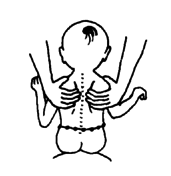
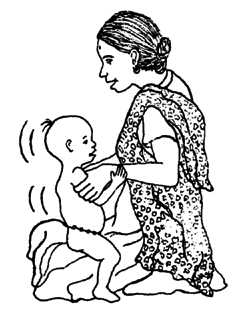
If the child cannot lift his head as you pull him up, then do not pull him up. Instead, sit the child up and gently tilt him back a little, encouraging him to hold his head up. Repeat often, and as he gains strength and control, gradually tilt him farther back- but do not let his head fall backward. |
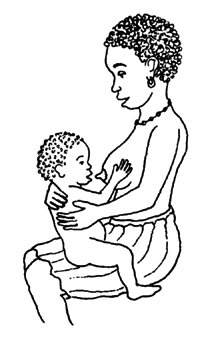
If the baby makes almost no effort to lift or hold her head when you feed her, instead of putting the nipple or food into her mouth, barely touch her lips with it, and make her come forward to get it. |
![]()
GOOD CARRYING POSITIONS
| Carrying the child like this helps develop good
head control, when he is face down.
|
| Positions that keep the hips and knees bent and
the knees separate help relax and give better control to the
child with cerebral palsy whose body straightens stiffly and
whose knees press together.
|
| Carrying baby like this frees his head and arms
to move and look around.
|
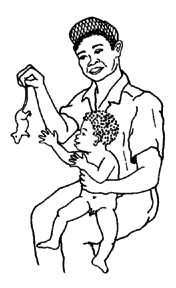
As your child develops better head control, play with him, supporting his body firmly, but with his head and arms free. Attract his attention with interesting objects and sounds, so that he turns his head first to one side and then to the other. |
2. Activities to encourage rolling and twisting
After a baby has fairly good head control, usually the next step in development is to roll over. Rolling involves sideways twisting of the head and body. Twisting, or rotation of the upper body on the lower body, must be learned before a child can learn to crawl and later to walk.
Babies normally learn by themselves to roll over. But children who are developmentally delayed will learn faster with special help and encouragement. Help the child learn first to lift and turn her head to the side, then her shoulders and body.
| Attract the child's attention by holding a rattle or toy in front of her, | Encourage her to reach sideways for the toy, |

|
|
| then move the toy to one side, so the child turns her head and shoulders to follow it. | then move the toy upward, so that she twists onto her side and back. |
![]()
If she does not roll over after various tries, help her by lifting her leg.

Note: If the child has spasticity, you may need to help position this arm before she can roll over.
Also, help the child learn to roll from her back onto her side. Again, have her reach for a toy held to one side.
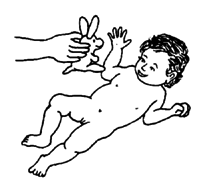
![]()
| Note: If the child is very stiff,
before doing other exercises or activities, first help to relax him by swinging his legs back and forth,
or curl up the child in a 'ball' and slowly roll his hips and legs from side to side.
Or twist his body to one side and then the other. Have him help by reaching for something he likes. Praise him when he does it. |
Remember: THE FIRST RULE OF THERAPY: HELP ONLY AS MUCH AS NEEDED, ENCOURAGING THE CHILD TO DO MORE AND MORE FOR HERSELF.
3. Activities to help develop gripping, reaching, and hand-eye coordination
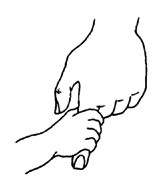
Most babies are born with a 'grasping reflex'. If you put your finger in their hand, the hand automatically grips it - so tightly you can lift up the child.
Usually this reflex goes away, and gradually the baby learns to hold things and let go as she chooses.
Babies who are slow to develop sometimes have little or no 'grasping reflex' and are slow to learn to hold things. For such children, these activities may help.
If she keeps her hand closed, stroke the outer edge of the hand from little finger to wrist.
This often causes the baby to lift and open her hand, and to grip your finger.

![]()

CAUTION: In a child with spasticity, stroking the back of the hand may cause her to grip or open the hand stiffly without control. If so, do not do it, but look for ways that give her more control. |
When the child opens her hands well, but has trouble holding on,
| place an object in her hand, and bend her
fingers around it. Be sure the thumb is opposite the
fingers.
|
| Gradually let go of her hand and pull the
object up against her fingers or twist it from side to side.
|
| When you think she has a firm grip, let go. Repeat several times in each of the child's hands.
|
After the child can hold an object placed in her hand, encourage her to reach and grasp an object that just touches her fingertips. First touch the top of her hand-then place it below her fingertips.

Encourage the baby to grasp by offering her rattles, bells, colorful toys, or something to eat on a stick.
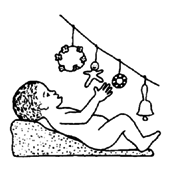
Hang interesting toys, bells, and rattles where the child can see and reach for them.
This way the child learns to move her hand forward to take hold of a toy.
If the child shows no awareness of her hand, hang little bells from her wrist.

Also, see Page 327 for ways to help a child discover her hands by putting a sweet food on her finger and helping her take it to her mouth.
At first a child can only grasp large objects with her whole hand. As she grows she will be able to pick up and hold smaller things with thumb and fingers. Help her do this by playing with objects of different sizes.

To help strengthen grip, play 'tug-of-war' with the child - making it a fun game.
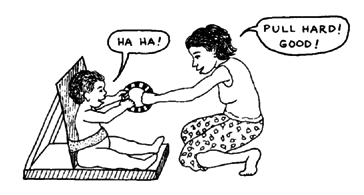
As the child gains more and more control, introduce toys and games that help develop hand-eye coordination. For ideas, see Page 318.

Make games of putting things in and out of boxes and jars.
Playing with toys and imitating the work and play of others helps the child gain more skillful use of his hands.
![]()
4. Activities for body control, balance, and sitting
After a child gains good head control, he normally starts sitting through these stages.
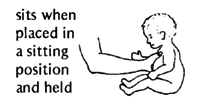
|
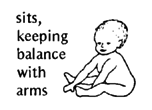
|

|
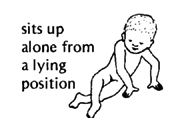
|
In order to sit well a child needs to be able to hold her body up, to use her hands to catch and support herself, and finally to balance with her body so that she can turn and reach.

If the child simply falls over when you sit him up, help him develop a protective reaction with his arms. Put him on a log, hold his hips, and slowly roll him sideways. Encourage him to 'catch' himself with a hand.
Or do the same thing with the child on your belly.

After the child learns to 'catch' herself when lying, sit her up, hold her above the hips, and gently push her from side to side,


and forward and backward so that she learns to catch and support herself with her arms.
| CAUTION: The child must be able to raise and turn her head before she can raise her body. |
| To help your child gain balance sitting, first sit her on your knees facing you. | |
| Hold her loosely so her body can adapt to leaning. |

|
| Later, you can sit her facing out so that she can see what is going on around her. | |
| Slowly lift one knee to lean her gently to one side. Then the other, so that she learns to bend her body to stay seated. |

|
You can do the same thing with the child sitting on a log.
As he gets better balance, move your hands down to his hips and then thighs, so that he depends less on your support.
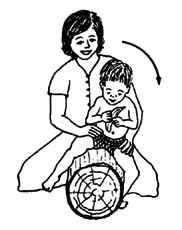
Give him something to hold so that he learns to use his body and not his arms to keep his balance.
| With an older child who has difficulty with balance, you can do the same thing on a 'tilt board'. |
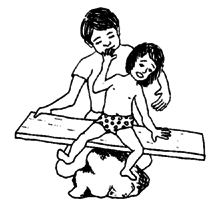
At first let her catch herself with her arms. |
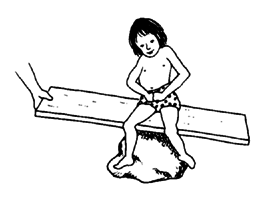
Later, see how long she can do it holding her hands together. Make it a game. |
| Or you can do the same on a large ball. |
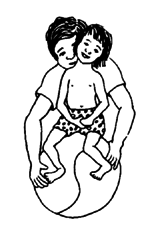
Tilt it to one side and the other and also forward and back. |
| Note: You can also do these
exercises by sitting the child on a table and gently pushing
him backward, sideways, and forward. But it is
better to tip what he is sitting on.
Pushing him causes him to 'catch himself' from falling with his arms. Tilting him causes him to use his body to keep his balance, which is a more advanced skill. |
Help the child learn to keep her balance while using her hands and twisting her body,
sitting on the ground,
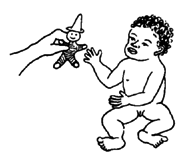
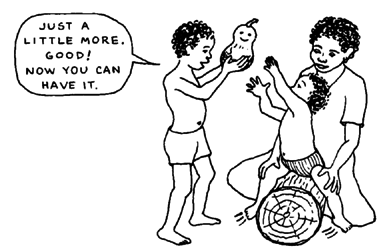
and sitting on a log or seat.
When the child can sit by herself, help her learn to sit up,
| from lying on her back,
As the child starts to rise, push on the higher hip. |
| and from lying on her belly.
First help her lift her shoulders. |
| Press down and back on hip.
Help her roll to one side, rise onto one elbow, and sit. |
Help her to sit up herself. Do not pull her up. Praise her each time she does well, or tries hard. Help her less and less until she can sit up alone.
Some children will need seating aids to sit well. To help improve balance, the aid should be as low as possible and still let the child sit straight. Often, firmly supporting the hips is enough. Here are 2 examples:
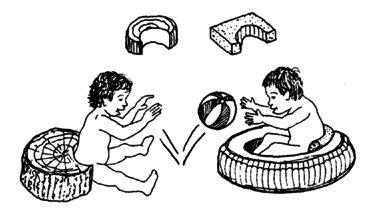
For the child who needs higher back support, simple 'corner seats' can be made of cardboard, wood, or poles in the ground.
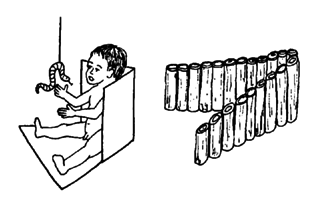
For more ideas on special seating and positioning, see Chapters 64and 65. For sitting aids, see Page 573.
5. Activities for creeping and crawling
To move about, many babies first begin to creep*,
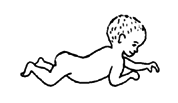
and then to crawl*,
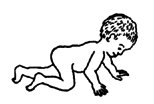
or to scoot on their butt.
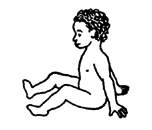
| Note: Some babies never crawl but go directly from sitting to standing and walking. Whether or not they crawl often depends on cultural patterns and whether the family encourages it. |
If the child can lift her head well when lying on her stomach, encourage her to begin creeping in these ways:
![]()
Put a toy or food the child likes just out of reach.
At first it may help to support his feet.
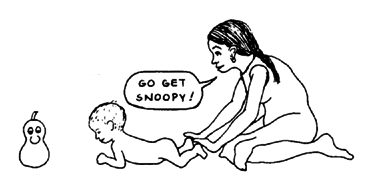
| CAUTION: If the child has cerebral palsy, supporting the feet may cause legs to straighten stiffly. If this happens do not support her feet. |
If the child cannot bring her leg forward to creep, help her by lifting the hip.

If the child has difficulty beginning to creep or crawl:
Let her 'ride' your knee. Play 'horsey'. Slowly move your knee up and down and sideways so that she shifts her weight from side to side.
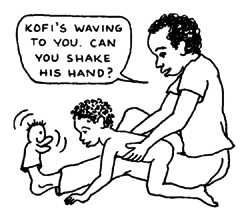
Encourage her to lift one hand off the ground and shift her weight to the other. Then help her to move forward.
Or put the child over a bucket or log. To help him bear weight with his elbows straight, firmly push down on his shoulders and release. Repeat several times.
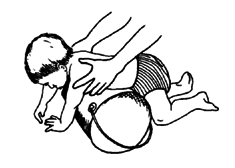
If the baby has trouble beginning to crawl, hold him up with a towel like this. As he gains strength, gradually support him less.
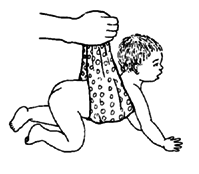
Move him from side to side so he shifts weight from one arm and leg to the other.
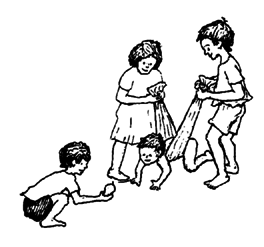
Older brothers and sisters can help.
Encourage the child to first reach-and later crawl- for something he wants.
*North American therapists use these terms in the reverse way (creep for crawl and crawl for creep).
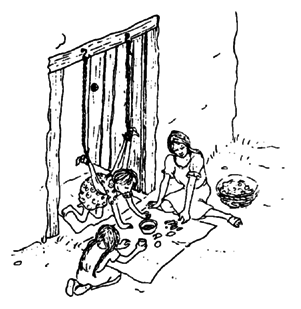
You can hang the child from a roof beam or branch, or a doorway, like this.
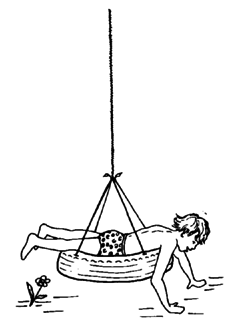
A child with spastic legs can hang with her legs supported to allow moving about using her arms.
Or make a simple 'creeper'.
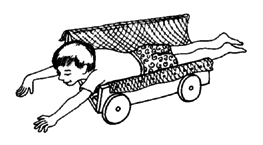
| When the child has learned to crawl fairly well, have
him play crawling games.
|
| She can crawl up and down a small hill or pile of straw.
This will help improve her strength and balance.
|
| To help an older child with balance problems to prepare
for walking, encourage him to crawl sideways and
backward.
|
| Also, have him hold one leg or arm off the ground and
shift his weight back and forth.
At first, you may need to hold up one limb while you slowly rock him from side to side. |
| Later, have him practice holding one arm and the
opposite leg off the ground at the same time.
|
| A 'rocker board' is fun and helps balance.
|
![]()
After a child gets her balance on hands and knees, you can help her begin to stand -and walk- on her knees. She can walk sideways along the rope.

| CAUTION: Do not do this in a child with spasticity whose knees bend a lot when she stands. |
There are many ways the child can practice standing on her knees and shifting her weight - ways that are fun and include her in family activities.
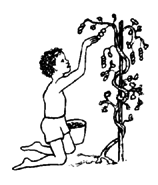
6. Activities for standing, walking, and balance
Normally a child progresses through these stages:
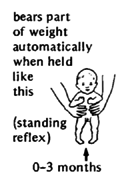
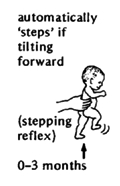
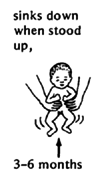
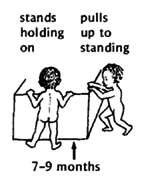
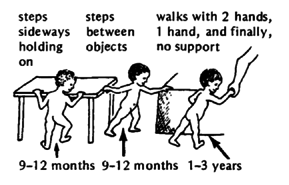
You can prepare a child for walking by encouraging each of the above stages as the child develops.
| CAUTION: If the child cannot balance when sitting, do not work on walking yet. Help her develop sitting balance first. |
![]()
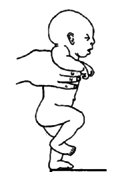
Hold the baby so that she uses the early stepping reflex to strengthen her legs. You can even bounce the baby gently.
| CAUTION: In children with spasticity, this activity may increase muscle stiffness. DO NOT DO IT. (See Page 93 and 291) |
When the child begins to stand, support her hips with your hands. Spread her feet apart to form a wide base. First do this from in front, later from behind.
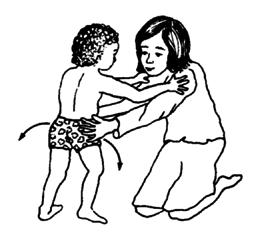
Move her gently from side to side, so that she learns to shift her weight from one leg to the other.
As she gains better balance, you can provide a light support at the shoulders.
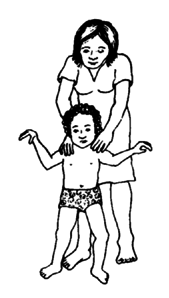
| Or have the child hold a hose or rope. Because it is
flexible, he needs to balance more.
Later, he can hold onto the rope with one hand only. |
| To encourage a child to pull up to standing, put a toy
he likes on the edge of a table.
To encourage him to take steps, put something he likes at the other end of the table. |
| When a child can almost walk alone but is afraid of
failing, tie a cloth around his chest.
Hold the cloth, but let it hang completely loose. Be ready to catch him if he falls. |
| CAUTION: Do not let the child hang by the cloth. Have him bear his own weight. The cloth is only to catch him if he falls. |
Other activities for improving balance:
Hold the child loosely under the arms and gently tip him from side to side and forward and backward. Allow him to return to a straight position. Turn it into a game.

At first support the child while you do this. When his balance improves, do it without supporting him-but be ready to catch him if he fails.
| Practice walking sideways and backward.
Note: Walking backward helps children who tend to walk tiptoe to bring their heels down. |
| It is better to hold a child:
LIKE THIS His balance is centered in his body.
NOT LIKE THIS His balance is off center. |
![]()
Support your child only as much as he needs, until he can walk by himself.
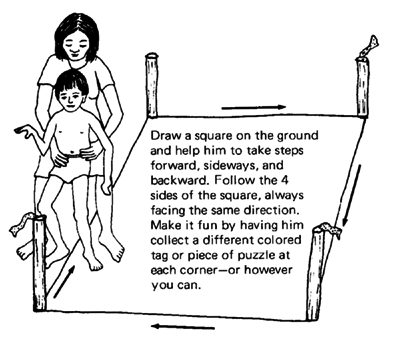
For the older child with poor balance, a homemade balance board will turn developing better balance into a game. Move slowly at first-especially with a child with cerebral palsy.

A balance board with a wide rocker is better because it rocks more smoothly. (See Page 576.)
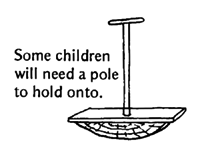
Simple homemade parallel bars can help a child with weak legs or a balance problem get started walking.
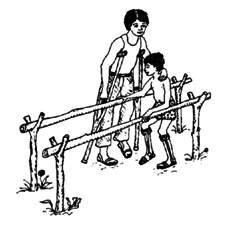
Homemade pushcarts or walkers can provide both support and independence for the child who is learning to walk or who has balance problems.
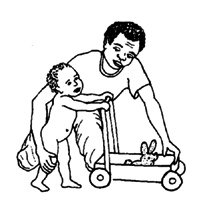
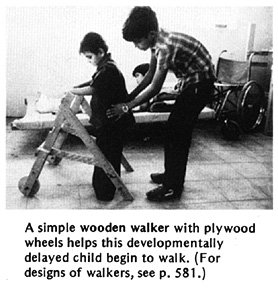
see Page 581.
7. Activities for communication and speech
A normal child's ability to communicate develops through these stages:
| expresses needs through body movements, looks on the
face, and crying
|
| makes 'happy sounds'-coos and gurgles
|
| babbles-listens to sounds and tries to imitate
|
| says a few words
|
| begins to put words (and ideas) together
|
| Learning that prepares a baby for speech begins early, long before she says her first word. Speech develops out of body movement, use of the mouth and tongue in eating, and use of the senses-through interaction with people and things. |
One of the early stages in a baby's development of speech is noticing and responding to different sounds. A delayed child may need extra help and stimulation.
Make noises with bells, rattles, clickers, and drums, first directly in front of the baby, then to one side, so that she turns her head.
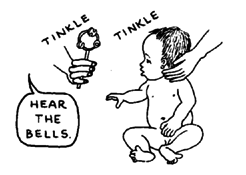
If she does not turn her head, bring the toy back so she can see it, and move it away again.
Or, gently turn her head so that she sees what makes the sound. Help her less and less-until she turns her head alone.
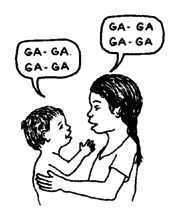
Repeat the babble of the child: have conversations with him in his language. But when he begins to say words, repeat and pronounce them clearly and correctly-do not use 'baby talk'.

To get the child used to language, explain everything you do with him. Use clear, simple words-the same ones each time. Name toys, objects, body parts. Repeat often.
Understanding language depends not only on hearing, but also on watching lips and looks. So speak to the child on her level.
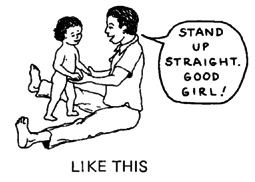
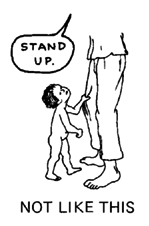
A child understands words before he can speak them. Play question games to help him listen and learn; he can answer your questions by pointing, nodding, or shaking his head.

Repeat words. Make small requests. Reward successes.
Rhythm is important to language development. Sing songs, play music, and have the child imitate body movements: clap your hands, touch your toes, or beat a drum.
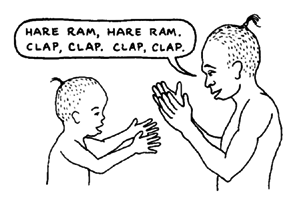
Imitate the sounds that baby makes and have him copy the same sounds when you make them. Then say words similar to those sounds.
Also, imitate use of the mouth: open wide, close tight, stick out tongue, blow air, push lips in and out.
| CAUTION: Encourage use of gestures, but not so much that the child does not feel the need to try to use words. |
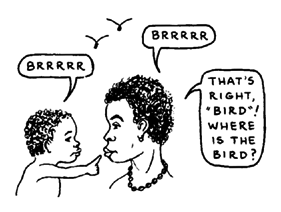
SPECIAL PROBLEMS IN SPEECH DEVELOPMENT
![]()
A mouth that hangs open or drools is a passive (inactive) mouth. It makes development of language more difficult. Often children with Down syndrome or the floppy type of cerebral palsy have this problem.
Here are some suggestions to help correct the problem of drooling and to help strengthen the mouth, lips, and tongue for eating and speaking ability.

CAUTION: If the child's mouth hangs open and she drools, do not keep telling her to close it! This will not help and will only frustrate the child. |

Stroke or tap the upper lip, or gently press the lower lip several times. |
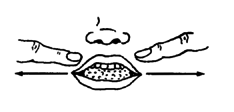
Or, gently stretch the lip muscles. This may help the child to close his mouth. |
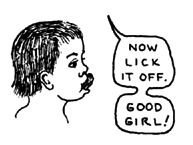
To strengthen the tongue and lips, put honey or a sweet, sticky food on the upper and lower lips. Have the child lick it off. |

You can also put sticky food on the inside of the front teeth and roof of the mouth. Licking this food helps prepare the tongue for saying the letters T, D, N, G, H, J, and L. |
Also have the child lick sticky food from a spoon and lick or suck 'suckers' and other foods or candies.
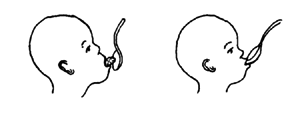
Put food into the side of the mouth and behind the teeth so that the child exercises the tongue. Also, have the child try to take food off a spoon with his lips.
Begin to give the child solid foods, and foods she needs to chew, as early as she can take them (after 4 months). This helps develop the jaw and mouth.
![]()
|
Play games in which you have the child:

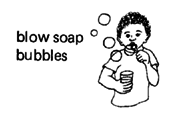


![]()
| CAUTION: For children with cerebral palsy, these blowing exercises may increase the uncontrolled tightening of muscles or twisting of the mouth. If so, DO NOT USE THEM. |
Encourage mouthing and chewing on clean toys (but not thumb sucking).

Help the child discover how to make different sounds by flapping her lips up and down with your finger,
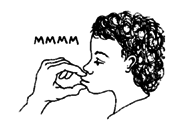
or by squeezing them together as she makes sounds.
![]()
For a child with cerebral palsy, you can help him control his mouth for eating or speaking by stabilizing his body in a firm position. Choose the position in which he is most relaxed (least spastic). This usually means bending the head, shoulders, and hips forward. For this reason it is sometimes said:
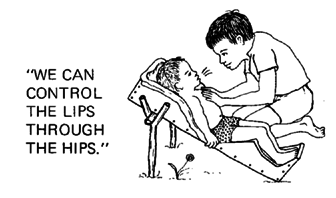
You can help the child make different sounds by pushing on and jiggling his chest.
Imitate the sounds he makes and encourage him to make them by himself.
If the child has trouble with controlling his jaw when he tries to speak, try using 'jaw control' with your fingers, like this. (See Page 323)
Have him repeat sounds that require jaw movement.

When the child has difficulty pronouncing words, do not correct her. Instead, repeat the words correctly and clearly, showing that you understand.
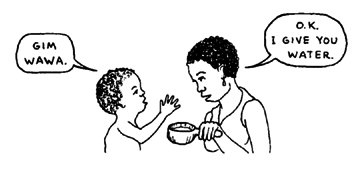
REMEMBER-The child needs a lot of stimulation of all her senses to develop language. Play with her, speak to her, and sing to her often. Ask her questions and give her time to answer. Do not try to 'make her learn', but give her many learning opportunities. Ask questions that need words for answers, not just 'yes' or 'no'.
![]()
Is your child deaf? If your child is slow to speak, check his hearing (see Page 447). Even if he hears some noises, he may not hear well enough to understand speech.
Also, some children who hear well may never be able to speak. For example, certain children with cerebral palsy cannot control their mouth, tongue, or voice muscles. For these children, as for young deaf children, we must look for other ways to communicate. (See Chapter 31.)
8. Early play activities and toys
Play is the way children learn best. So try to turn every activity you do with a child into some kind of play or game.
It is not what you do, but how you do it that makes something play. As long as it is fun and the child wants to do it, it is play. But if it stops being fun, or the child does it only because 'he has to', it stops being play. Small children (and big children who learn slowly) only stay interested in the same thing for a short time. The child soon gets bored and stops learning. Therefore, for activities to be play and stay play,
- continue with the same activity for a short time only, and
- look for ways to keep changing the activity a little so that it is always new and interesting.

Both boys in these pictures are doing the same learning activity. For one, it is play. For the other, it is not. Can you say why? |
Not all play has to be organized or planned; often the child learns most when it is not. Play needs some aspect of adventure, surprise, and freedom. It is important that a child learn to play with other children. But it is also important that she be given the chance and encouraged to play alone. She needs to learn to enjoy and live with other people-and with herself.
We do not talk much about play separately, because mostly it is not a separate activity. It is the best way to do almost any activity. For this reason, in this whole chapter-and book-we often give ideas for turning exercise, therapy, and learning into play.
Play activities, like other activities, should be picked so that they 'fit' a child's level of development and help him move one step farther. They should be HARD ENOUGH TO BE INTERESTING, but EASY ENOUGH TO BE DONE WELL. For example:
If the child is at the level of a very young baby, play games that help him use his eyes and hold up his head.
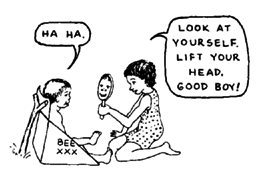
If the child is at the level where she sits, but finds it hard to keep her balance or open her knees, look for play that helps her with these.
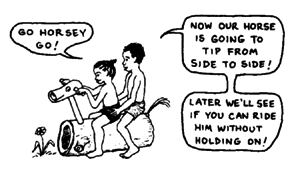
If in preparation for standing and walking the child needs practice shifting weight from one knee to the other, you might try imitation games. Here are 2 ideas:

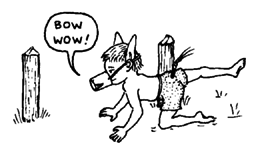
TOYS AND PLAYTHINGS TO STIMULATE A CHILD'S SENSES
Play is more important than toys. Almost anything-pots, flowers, sandals, fruit, keys, an old horseshoe-can be used as a toy, if it is used in play.
Toys -or 'playthings'- offer stimulation for a child, both when she plays by herself and when she plays with others. Many simple things in the home can be used as toys, or can be turned into them.


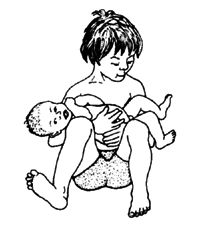
Caring for babies provides a learning experience that combines work and play for the child who is gentle.
| CAUTION: Take care that toys are clean and safe for the child. |
Here are a few examples of interesting toys. Use your imagination and the resources of your family to make toys.
Toys for touching
soft clothes or blanket, baby animals, corn on the cob, finger paints, inner tubes for swimming, bathing ,nuts and bolts, toes and fingers, seed pods, mushy food, cloth doll, gourds, sand
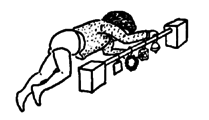
clay string chain pulley gears rocks beads fruits mud

For children who have trouble controlling their movements, and often drop or lose their toys, it may help to tie the toys with string, as shown here.
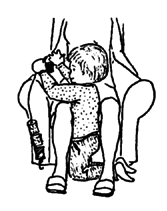
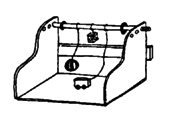
Toys to taste or smell
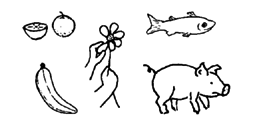
foods, flowers, fruits, animals, spices, perfumes
Toys for seeing
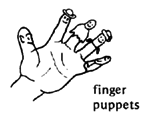
mirrors, colors, colored paper or tinfoil, daily family activity, puppets, old magazines with pictures, crystal glass pieces (rainbow maker), flashlight (touch)
Toys for balance
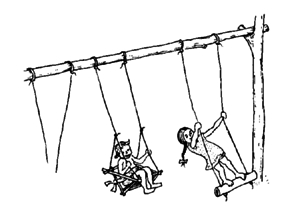
swings, hammocks, seesaws, rocking horses
Toys for hearing
rattles, guitar, flutes, drum, bells, bracelets on baby's wrist and ankles that tinkle when baby moves

marimba or xylophone, wind chimes, whistles, pet birds, animal sounds, seashells or other echo toys, talking, laughing, singing
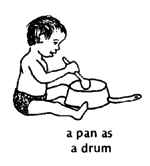
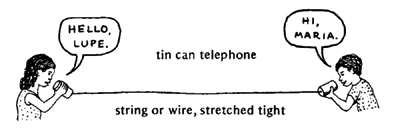
TOYS TO DEVELOP A CHILD'S MIND AND HAND-EYE COORDINATION
Learning to fit things into things
Start simple-dropping objects into a jar, then taking them out again.

As the child develops, make things more complex.
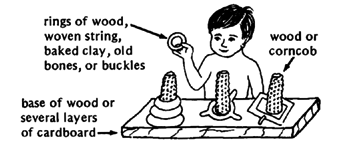
Note: Rings can be of different sizes, colors or shapes so that the child can also learn to match these.
To help develop controlled movement of the hands and arms, the child can move beads or blocks along a rod or wire.

Using animals or funny figures makes the exercise more fun. Other children will be more likely to join in the game.
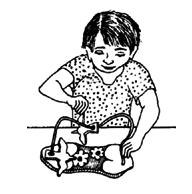
Matching games
The child can match objects of similar shape, size, and color.

Small pegs glued onto cut-out pieces help develop fine hand control.
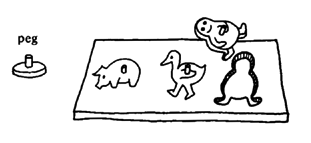
Start with simpler games with square or round figures.

Then progress to more complicated games with different shaped figures.
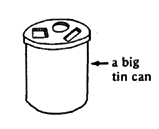


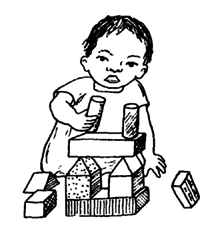
Puzzles
Jigsaw and block puzzles and building blocks also help a child learn how shapes and colors fit together. Suggestions for making different puzzles are on Page 476.
Many more ideas for simple toys are included in Chapter 49, "A Children's Workshop For Making Toys," Page 463 to 476.


